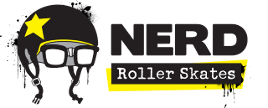Want to Roller Derby? Start With Skates!
|
So you want to play Roller Derby? Awesome! You will need;
We can’t pack those things up for sale, but we can help you with a basic starter package that includes; skates, a helmet, a mouth guard, knee and elbow pads, and wrist guards. |
SkatesSkates are your most important piece of gear. You might start on vintage specials or borrowed skates, but the sooner you have a pair of skates that fit you well the sooner you will start to build your skill. If your feet are in ill-fitting skates your brain is too busy thinking “Oh no, I’m unstable! I can’t feel my toes! Am I bleeding?!?” to actually learn anything. You want your brain to be thinking “Hey, this movement propelled me faster, that’s how you change direction, let’s go over there and block that Jammer… Shazam!” “Package” skate is one where the factory has put together all the parts and it comes out of the box ready to go on your feet. “Custom” skate can mean anything from having your feet cast to make a one of a kind last to build your boot, to simply choosing a boot, plate and wheels from different manufacturers and having your friendly neighbourhood Skate Nerds put it together. |
Skate Boots are Not Street ShoesSkate boots need to fit very snug and this can feel weird, especially if you love Flip Flops. Most skates are sized on a men’s last, so women will need to go at least one size smaller than their shoe size. When trying on a skate, push back into the heel before doing up the laces. When you put your weight on your foot with the laces done up your toe should just barely brush the end of the boot. If you have space between the end of your toe and the end of the boot, you will slide into that space when you go up on your toe stops. When the skate is laced up, grasp the back wheels and try to lift your foot out of the skate. If your heel moves up and down, the skate is either too big or too wide. If your toes are curled inside the boot or they are pushing against the end, then the skate is too small. When you try on skates, don’t be afraid to stand around for a while and feel it out. You should not be feeling pain or pressure in your feet. |
Leather vs Vinyl BootsMost inexpensive starter skates have padded vinyl boots. While this makes them comfortable at first, with wear and tear the padding breaks down. Leather boots have the ability to give and stretch over time. New leather boots will require a break-in period, but once they have worked in to the shape of your foot they will be comfortable and longer lasting. Note that leather boots don’t magically change size during the break in process; if the boots don’t fit now, they won’t fit after breaking in. |
PlatesThe plate is the part under the boot that has the trucks and toe stops. Most starter skates have a nylon or plastic plate. This makes them inexpensive and lightweight, but also means they are not as stiff and durable. Metal plates perform better and last longer. Trucks: the part of the skate that has the axle and the pivot pin. Kingpins: are the bolt that goes from the plate through the truck, Cushions: are the rubbery donut shaped parts that go on the kingpin on either side of the truck. Adjusting trucks and cushions is something that you will want to get familiar with right away. Many skates come out of the box with very stiff cushions, and with the trucks tightened right down. This means it’s hard for the trucks to compress the cushions when you lean to one side to turn, making it a struggle to change direction and keep grip in the corners. Trucks are too tight if the cushions are bulging, or you can’t move them with your hands. Trucks are too loose if they rattle when you shake the skate around, or if you feel them wobbling when you coast on a straight line. Choose a hardness of cushion based on your weight and skating style; a softer cushion will compress more easily and a harder cushion will offer more resistance to a forceful push. |
Toe StopsToe stops screw in to the plates and are held either by a nut, or a set screw. If your toe stops have a nut, make sure you check it every time you skate to make sure it is tight. Most toe stops come in a standard and a short version. If you like to screw the stops all the way in to the plate, choose a short stem. Always ensure that you have at least 1cm of thread in to the plate, or you risk breaking the stop right out of the plate. Some practice spaces demand non marking toe stops. If your league requires this, choose stops that are made of natural (non dyed) rubber, or that are labelled “non marking”. |
Axle nutsWheels should spin freely without being loose so that you can slide them on the axle. |
| Happy Skating! |
